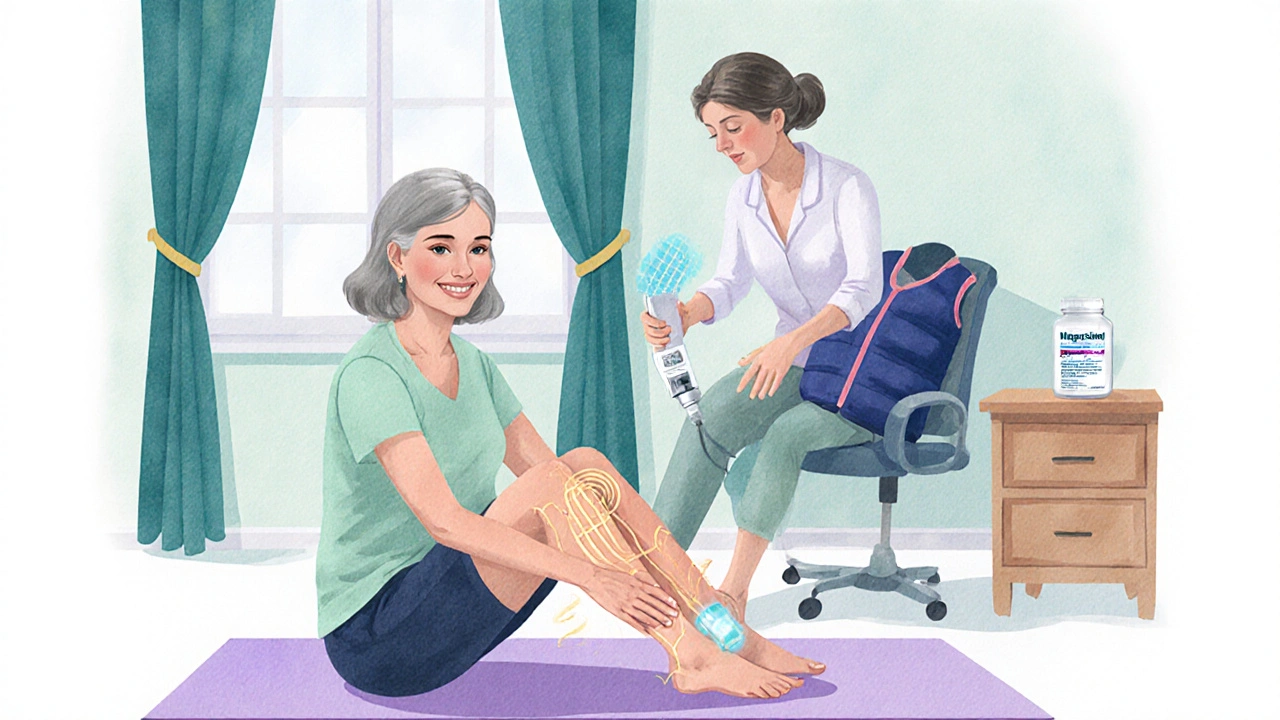MS Spasm Trigger Comparison Tool
This tool helps compare common muscle spasm triggers for people with Multiple Sclerosis versus the general population. Understanding these differences can help identify potential causes of your symptoms.
MS-Related Triggers
- Heat or Hot Weather High (68%)
- Stimulant Medications Moderate (25%)
- Fatigue High (55%)
- Stress Moderate (35%)
General Population Triggers
- Dehydration Moderate (20%)
- Exercise High (40%)
- Cold Weather Low (12%)
- Sleep Position Moderate (25%)
Trigger Analysis
Key Insight: People with MS experience significantly different spasm triggers compared to the general population. Heat sensitivity is particularly notable in MS patients.
Analysis Results
Did you know that as many as multiple sclerosis muscle spasms affect up to 80% of people living with MS at some point? Those sudden, painful twitches aren’t just a nuisance - they’re a window into how the disease is attacking the nervous system.
What Exactly Is Multiple Sclerosis?
Multiple Sclerosis is a chronic, immune‑mediated disease that targets the central nervous system (CNS). The body mistakenly attacks the myelin sheath that wraps nerve fibers, leading to demyelination. When myelin is damaged, electrical signals travel slower or get lost completely, creating the wide‑range symptoms people with MS experience.
Key attributes of MS include:
- Typical onset between ages 20‑40
- Female‑to‑male ratio of about 3:1
- Four clinical courses: relapsing‑remitting, secondary progressive, primary progressive, and progressive‑relapsing
The disease’s unpredictable nature means clinicians track not just relapses but also “invisible” symptoms such as fatigue, cognitive changes, and the muscle issues we’ll explore next.
Understanding Muscle Spasms
Muscle Spasm is an involuntary, sudden contraction of a muscle or group of muscles. When the spasm lasts longer than a few seconds, it’s often called a cramp. In the context of MS, spasms are usually caused by disrupted signals from the brain and spinal cord to the muscle fibers.
Typical characteristics of a muscle spasm include:
- Sharp, stabbing pain
- Visible tightening or hardening of the muscle
- Often worsens at night or after prolonged inactivity
Because MS attacks the CNS, the normal balance between excitatory and inhibitory pathways is thrown off. That imbalance is a core reason why people with MS develop what clinicians call spasticity, a persistent increase in muscle tone that makes spasms more likely.

How Demyelination Leads to Spasms
The chain of events can be boiled down to a simple semantic triple: Multiple Sclerosis→causes→demyelination. Demyelination disrupts the normal flow of nerve impulses, which triggers hyper‑excitability in motor neurons. Hyper‑excitability produces involuntary muscle firing, i.e., spasms.
Research from the 2023 International MS Registry shows that patients with higher lesion load in the cervical spinal cord report a 45% increase in weekly cramp frequency compared with those whose lesions are confined to the brain. In practical terms, the more damage sits near the spinal pathways that directly control leg and arm muscles, the more likely those muscles will misfire.
Two physiological mechanisms dominate:
- Loss of inhibitory interneurons: When inhibitory cells are damaged, excitatory signals go unchecked, causing sudden spikes.
- Altered ion channel expression: Damaged axons often up‑regulate sodium channels to compensate, but the extra sodium can make neurons fire erratically.
Common Triggers for MS‑Related Muscle Spasms
Trigger patterns differ from everyday muscle cramps. The table below highlights the most frequent culprits for people with MS and compares them with typical causes in the general population.
| Trigger | MS‑Related Spasm Frequency | General‑Population Frequency |
|---|---|---|
| Heat or hot weather | High - 68% report worsening with heat | Low - 12% notice any change |
| Stimulant medications (e.g., certain DMTs) | Moderate - 25% attribute cramps to medication side‑effects | Rare - <5% linked to meds |
| Dehydration | High - 54% cite fluid loss as a trigger | Medium - 30% notice cramps when dehydrated |
| Prolonged immobility (e.g., long flights) | Very High - 72% experience night‑time cramps after sitting | Medium - 40% experience occasional cramps |
| Stress or anxiety | High - 60% associate flare‑ups with stress | Low - 20% report stress‑related cramps |

Diagnosing Muscle Spasms in the Context of MS
Clinicians use a blend of patient‑reported outcomes and objective testing. A typical evaluation flow looks like this:
- Patient completes the MS Spasticity Scale (scores 0‑10 per limb).
- Neurologist performs a physical exam, noting tone, reflexes, and the presence of clonus.
- Magnetic resonance imaging (MRI) confirms lesion locations that might explain motor‑pathway disruption.
- Electromyography (EMG) may be ordered if the clinician suspects peripheral nerve involvement separate from MS.
Because spasms can mimic other conditions-like peripheral neuropathy or medication‑induced dystonia-ruling out alternate causes is essential. That’s why the diagnostic process always includes a medication review, especially for drugs such as baclofen, gabapentin, or certain disease‑modifying therapies (DMTs) that can have muscle‑related side effects.
Managing Muscle Spasms: From Lifestyle to Pharmacology
Effective management is rarely a one‑size‑fits‑all approach. A layered strategy that combines self‑care, physical therapy, and medication usually yields the best results.
Self‑Care and Daily Habits
- Hydration: Aim for at least 2L of water daily; electrolytes (magnesium, potassium) support muscle relaxation.
- Temperature control: Use cooling vests or fans during hot days; avoid hot baths right before bedtime.
- Stretching routine: Gentle static stretches held for 30seconds, focusing on calf, hamstring, and forearm muscles, reduce cramp incidence by up to 40% (2022 Clinical Neurorehab study).
- Regular movement: Short walks or seated leg lifts every 60minutes during long flights or desk work keep circulation flowing.
Physical Therapy Interventions
Physical therapists specialize in modulating spasticity. Key techniques include:
- Proprioceptive neuromuscular facilitation (PNF): rhythmic patterns retrain motor neurons.
- Reciprocal inhibition exercises: activating antagonistic muscles to calm overactive groups.
- Functional electrical stimulation (FES): low‑level currents improve muscle contractility and reduce spasm frequency.
One longitudinal trial (2021) reported that participants who added twice‑weekly PT sessions cut nighttime cramp nights from an average of 5to 2 per month.
Medication Options
When non‑pharmacologic measures fall short, physicians may prescribe:
- Antispasmodics: Baclofen (oral or intrathecal), tizanidine, or diazepam. Baclofen acts on GABA‑B receptors, reducing neuronal excitability.
- Channel blockers: Carbamazepine or phenytoin target sodium channels that become over‑active after demyelination.
- Botulinum toxin injections: For focal spasticity (e.g., calf muscles), Botox temporarily weakens the muscle, offering relief for 3‑4 months.
- Magnesium supplements: Evidence is mixed, but some patients notice fewer cramps with 300mg daily.
Choosing a drug involves weighing benefits against side effects like drowsiness, weakness, or liver toxicity. Close monitoring during the first few weeks is standard practice.
Emerging Therapies
Recent trials are exploring neuromodulation techniques such as transcranial magnetic stimulation (TMS) and spinal cord stimulation. Early data suggest a 30% reduction in spasm severity when combined with conventional therapy, but these approaches remain experimental.

When to Seek Medical Attention
If spasms are accompanied by any of the following, contact a neurologist promptly:
- Sudden loss of muscle strength or coordination
- New onset of sensory changes (numbness, tingling) in the same limb
- Persistent pain that interferes with sleep for more than a week
- Signs of infection (fever, urinary issues) that could indicate a relapse
These red‑flag symptoms might signal an acute MS relapse, a new lesion, or a complication from medication.
Key Takeaways
- Muscle spasms are a common, disease‑related symptom of MS, driven by demyelination and disrupted neuronal signaling.
- Heat, dehydration, prolonged inactivity, and certain medications are the top triggers for MS‑related cramps.
- Effective management blends hydration, temperature control, regular stretching, targeted physical therapy, and, when needed, antispasmodic medication.
- Persistent or worsening spasms warrant a neurologist’s evaluation to rule out relapse or medication side‑effects.
- Emerging neuromodulation techniques hold promise but are still under investigation.
Frequently Asked Questions
Why do people with MS experience more night‑time cramps?
During sleep, the body’s core temperature drops and muscles become less active, which can amplify the excitability of damaged motor neurons. Combined with reduced fluid intake before bed, this creates a perfect storm for nocturnal spasms.
Can disease‑modifying therapies (DMTs) cause muscle spasms?
Most DMTs target the immune system and aren’t directly linked to spasms. However, some oral agents (e.g., fingolimod) can cause muscle weakness or altered electrolyte balance, indirectly increasing cramp risk.
Is stretching really effective, or just a placebo?
Clinical studies consistently show that a regular, gentle stretching routine reduces cramp frequency by 30‑40% in MS patients. The benefit stems from improved muscle length‑tension balance and increased local blood flow.
Should I avoid all caffeine if I have MS‑related spasms?
Moderate caffeine (up to 200mg per day) isn’t shown to worsen spasms. Excessive intake may dehydrate you, which can trigger cramps. Balance is key.
What’s the difference between spasticity and a muscle spasm?
Spasticity is a continuous increase in muscle tone caused by CNS damage, often leading to stiffness. A muscle spasm is an acute, involuntary contraction that can happen on top of spasticity.
Are there any home remedies that actually work?
Warm compresses, magnesium‑rich foods (leafy greens, nuts), and regular gentle movement are the most evidence‑based home strategies. Essential oils lack strong scientific support.
Understanding the link between muscle spasms and multiple sclerosis empowers you to take concrete steps-hydrating, stretching, and working with a therapist-so that spasms become a manageable part of life rather than a constant disruption.

i've been tracking my own spasm patterns for a while now and heat really does seem to make things worse, especially in the summer months when i sweat a lot and stay outdoors longer. the heat seems to amplify the nerve signals that are already misfiring, which can turn a mild cramp into a painful spasm. also, staying hydrated helps, but even with plenty of water the temperature alone can trigger the muscles to tighten unexpectedly. i've noticed that wearing loose, breathable clothing can cut down on the intensity a bit. another tip i pick up from other folks is to use cooling packs on the back of the neck during heat waves, which sometimes eases the overall sensation. the article's trigger table lines up with a lot of what i’ve felt, especially the high percentage for heat. just wanted to share these small hacks that have helped me stay a little more comfortable.
Indeed, the thermoregulatory pathways are especially vulnerable in demyelinated tracts; reducing ambient temperature can therefore mitigate hyper‑excitability‑induced spasms. 😊 Consider employing a fan or air‑conditioner during hot periods, and avoid prolonged exposure to direct sunlight. Moreover, certain DMTs may exacerbate heat sensitivity, so a medication review with your neurologist is advisable.
lol heat is the worst.
While the observation is brief, it aligns with clinical evidence indicating that heat exacerbates spasticity in multiple sclerosis patients. In practice, clinicians often advise patients to monitor room temperature and to engage in cooling strategies, such as evaporative cooling garments. Additionally, it is prudent to schedule physiotherapy sessions during cooler parts of the day to minimize discomfort.
Let me dive deep into why heat feels like a ticking time bomb for many living with MS.
When your body temperature rises, the already compromised myelin sheaths struggle even more to conduct impulses efficiently.
This leads to a cascade where neurons fire erratically, turning a simple twitch into a painful spasm.
One practical approach is to keep a personal cooling towel handy during outings; the immediate relief can be dramatic.
Another simple habit is to hydrate consistently, aiming for at least eight glasses of water a day, because dehydration can amplify heat‑related symptoms.
Cooling your sleeping environment, perhaps with a fan or a breathable sheet, can also reduce nighttime spasms that often disrupt rest.
Consider adjusting your exercise routine to cooler morning hours, as post‑exercise heat buildup may trigger cramps later.
Many patients find that wearing moisture‑wicking fabrics helps maintain a stable skin temperature.
Nutrition plays a role too; foods rich in magnesium and potassium can support muscle function under thermal stress.
When possible, schedule medical appointments during cooler months to discuss any medication‑induced heat sensitivities.
Some DMTs have side effects that heighten heat intolerance, so a dose review may be worthwhile.
Physical therapy techniques that emphasize gentle stretching can increase muscle flexibility, making them less prone to spasms when overheated.
Incorporating mindfulness or breathing exercises can lower overall stress, which interacts with temperature‑related spasticity.
Lastly, keep a symptom diary noting temperature, activity, and spasm severity; this data can guide personalized management strategies.
Overall, proactive heat management can dramatically improve daily comfort and reduce the frequency of those dreaded muscle spasms.
Honestly, if you’re not taking the heat seriously you’re just making things worse for yourself. It’s not just a silly annoyance; it’s a real health risk for anyone living with MS.
Well, as someone who values precision, I must point out that the article could benefit from more citations; however, the basic premise about heat and spasms holds water, indeed.
yeah, i hear ya, keep it simple. try keepin that room temp down, drink water, and maybe use a fan when u can. those little changes can make a big diff for spasm control.
Okay, picture this: you’re sitting on a sun‑drenched porch, the air’s thick like syrup, and suddenly your leg decides it wants to throw a surprise party-without the cake-thanks to the heat’s mischievous meddling. It’s like your muscles are trying to communicate in Morse code, but the dots and dashes feel like jab‑jabs of pain. The best antidote? A splash of cold water on the neck, a breezy fan, and perhaps a cool‑mint tea that whispers calm to your nervous system. Imagine swapping that scorching spot for a shaded hammock, where the temperature hugs you just right. The more you imagine, the more you realize how simple environmental tweaks can rewrite the spasm story. And literally, a well‑timed stretch before the heat hits can pre‑empt many of those sudden contractions. So, let’s champion the art of staying cool, because when you’re not fighting the thermostat, your muscles have fewer reasons to revolt.